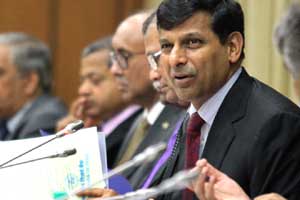Close on the heels of the RBI springing a surprise by reducing repo rate by 50 bps, public sector lenders State Bank of India and Andhra Bank cut their base rates by 40 bps and 25 bps, respectively. Other bankers also indicated that a cut is certain. However, lenders said that deposit rates will also be lowered with SBI announcing a 25-bps cut in various maturities, effective October 5.
SBI chairman Arundhati Bhattacharya told a business news channel that when the RBI raised repo rate by 75 bps, banks increased rates only by 35 bps. When RBI brought it down by 75 bps, banks lowered it by 35 bps. “This time, the RBI has cut the repo by 50 bps and we have transmitted 40 bps. So, going forward, as the book reprises properly and as we begin to see credit growth come in, we will definitely keep looking at ways and means of bringing down the rates further,” she said. However, Bhattacharya cautioned that the bank is likely to face margin pressures due to the cut in base rate.
(Video) Explained: RBI cuts rate – what it means for customers like you
Base rates of banks stand in the range of 9.3-10% with SBI at 9.3%, followed by HDFC Bank at 9.35%, ICICI Bank at 9.7% and Andhra Bank at 9.75%. While RBI has lowered repo rate by 125 bps since January, banks have passed on a maximum of 70 bps.
ICICI Bank MD & CEO Chanda Kochhar said base rates will come down and a large part of the cut will get transmitted. “When I say a large part of the thing will get transmitted, it means more than half, but beyond that I can’t sit here and take my asset liability committee’s (Alco) decision,” she said.
Aditya Puri, managing director of HDFC Bank, which recently lowered its base rate to 9.35%, said: “When they (RBI) lower the rates, we lower our deposit rates and then we lower the base rates, but it (base rate) is coming down.”
On credit demand, Kochhar said all banks are seeing retail credit growth to be quite robust and substantial and car sales are growing in quite a balanced and robust manner. “We have seen commercial vehicles sales grow in a robust manner. We are also seeing that with the government spending that happened in July and August, some of the contractors — some of the very large ones, some of the very small ones — have started getting contracts and, so, I think in that sense, all these are signs of activity where the credit demand will go up,” she said.
RBI data showed that non-food credit grew 9.88% in September 4 fortnight to Rs 65.99 lakh crore and deposits grew 11.59% to Rs 90.3 lakh crore in the same period.
Meanwhile, RBI has also said it will lower the risk-weights assigned to the lower rung of home loans and bankers said although the central bank has not specified how much it will be brought down to, it would allow banks to have more capital to lend. “We have to see what that number will be like because they have not come up with a number, but having said that, we will look at the low-value loans that are well collaterised to bring down the risk weights,” Bhattacharya said, adding that, today, with a 50% risk weight, the capital cost is around 80-90 bps.
“So, if that is brought down, obviously there will be a little extra we can do and it should definitely add to the positive sentiment.”
Kochhar said home loan rates have anyway been moving down irrespective of the fact whether the base rates come down or not. “Home loan rates are very competitive and, as the regime become softer, rates will become softer as well,” she said.
Led by SBI, banks have been cutting deposit rates since October last year and a one-year term deposit earns 7.5% (before the 25-bps cut to come on October 5). Bankers have said that since the cut on deposit rates is only effective on fresh deposits, it takes at least two quarters for the bank to realise the benefit of lower cost of funds. However, lenders said with a cut in base rate, all loans will become cheaper, which will affect their margins immediately.
Keki Mistry, vice-chairman and CEO, HDFC, said there is room for lending rate cuts, depending on the fall in cost of funds and on the definition of affordable housing for which RBI is looking at lower risk weights for home loans of lower value.
According to a more recent definition, Mistry said, affordable housing is defined as loans of Rs 40 lakh and property values of Rs 50 lakh in non-metro cities and Rs 50 lakh and property value of Rs 65 lakh in metros. “If we go by the recent definition, it covers around 60% of our loan book. Our average loans size is Rs 23.4 lakh for new loans in the current year and, therefore, my sense is that depending on the definition, a substantial portion of our book will get covered,” he said.


